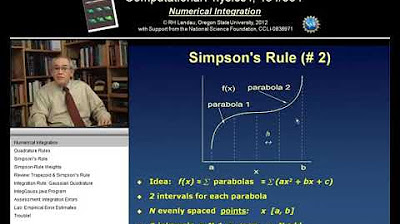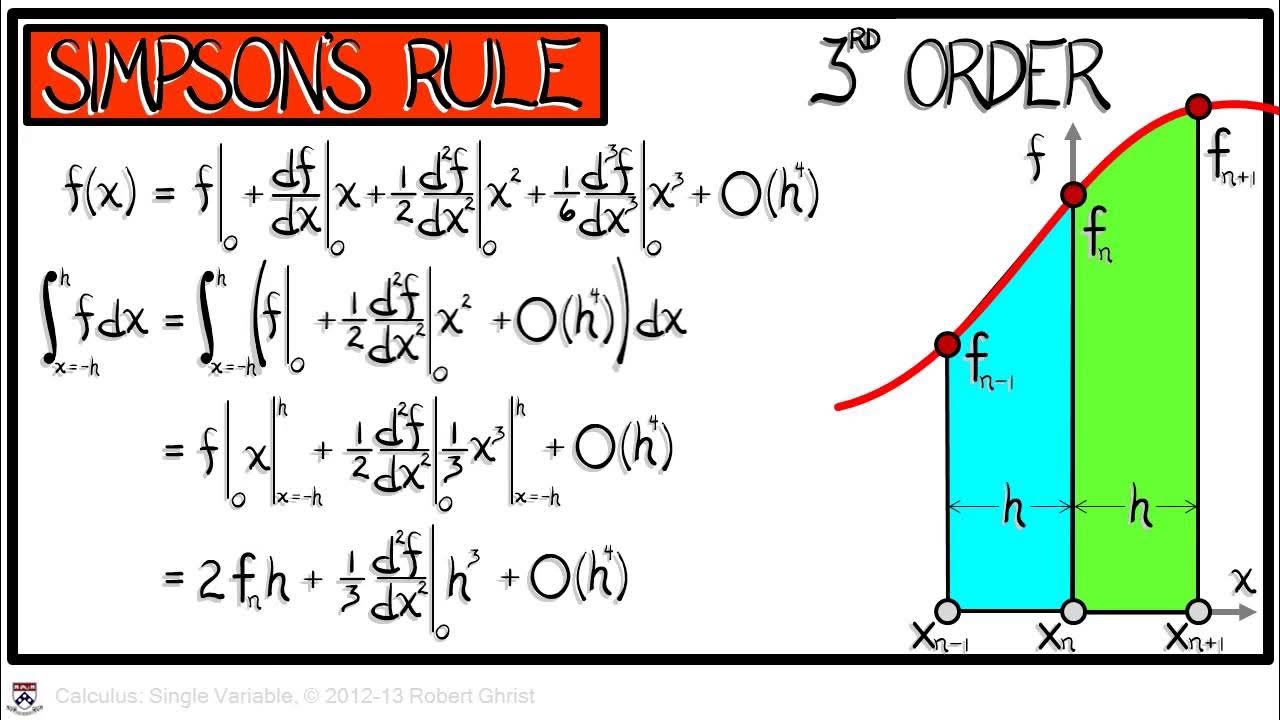Numeric Integration with Python — Topic 89 of Machine Learning Foundations
TLDRThis video from the Machine Learning Foundation series provides a practical demonstration on how to compute definite integrals using Python, focusing on a transition from symbolic to numerical integration methods. The example discussed is the integration of the function x/2 over the range 1 to 2, which symbolically equals three-quarters. The tutorial walks through the computational approach using the quadrature method from the SciPy library, highlighting its efficiency and the minimal error involved in numerical calculations. This hands-on demo, set in a Jupyter notebook, aims to enhance understanding of both symbolic and numerical integration in practical applications.
Takeaways
- 📚 The video introduces a method to calculate definite integrals computationally using Python code.
- 📊 In the previous video, the definite integral of (x/2) from 1 to 2 was calculated manually, resulting in (3/4).
- 💻 The hands-on code demonstration is conducted in a Jupyter notebook from the presenter's GitHub repository.
- 🔍 Before running the notebook, ensure all dependencies are loaded by executing the preceding cells.
- 📝 The `quad` function from the `scipy.integrate` module is used for numerical integration, also known as quadrature.
- 🔢 Numerical integration is a computational technique as opposed to the symbolic integration done manually in the previous video.
- 🎯 The `quad` function requires a function to integrate and the limits of integration as arguments.
- 👉 A simple function `g` is defined to represent (x/2) for the purpose of the integration.
- 🧮 The `quad` method returns a tuple with the first item being the result of the integration and the second being an error estimate.
- 📈 The result of the integration using `quad` is 0.75, which matches the manual calculation, and the error is negligible.
- ⚡ Numerical integration is presented as a fast, intuitive, and straightforward method for calculating definite integrals.
- 📚 The next video will include an exercise to test understanding of definite integrals using both symbolic and numeric approaches.
Q & A
What is the main topic of the video?
-The main topic of the video is to demonstrate how to calculate definite integrals computationally and automatically using Python code.
What was the example given in the preceding video?
-The example in the preceding video was to calculate the definite integral of the equation (1/2)x over the range of 1 to 2 using symbolic integration rules.
What is the result of the definite integral calculation from the example in the video?
-The result of the definite integral calculation is three quarters, representing an area of three quarters of a squared unit.
Which Python library is used for numerical integration in the video?
-The video uses the 'quad' function from the 'scipy.integrate' module for numerical integration.
What does the 'quad' function stand for?
-The 'quad' function stands for quadrature method, which is a numerical integration technique.
How is numerical integration different from symbolic integration?
-Numerical integration is a computational approach that uses algorithms to approximate the value of an integral, whereas symbolic integration uses mathematical rules and symbols to find an exact solution.
What is the function defined in the video for the purpose of numerical integration?
-The function defined in the video is 'g', which is a simple function that returns x divided by 2.
What are the arguments required by the 'quad' function for performing numerical integration?
-The 'quad' function requires the function to be integrated as the first argument, and the lower and upper limits of integration as the remaining arguments.
What is the result of the numerical integration for the given function and range in the video?
-The result of the numerical integration is 0.75, which matches the symbolic integration result of three quarters.
What is the second item in the tuple returned by the 'quad' function?
-The second item in the tuple is an estimate of the error in the numerical integration.
Why is numerical integration considered fast and intuitive?
-Numerical integration is considered fast and intuitive because it allows for quick computation of integrals without the need for manual symbolic manipulation, making it easier to apply in code.
What is the next step suggested in the video after demonstrating numerical integration?
-The next step suggested is an exercise to test understanding of definite integrals using both the manual symbolic approach and the automated numeric approach covered in the video.
Outlines
📚 Introduction to Calculating Definite Integrals with Python
This paragraph introduces the concept of calculating definite integrals using Python code, as opposed to manual symbolic integration. It references a previous video where the definite integral of (1/2)x was calculated manually over the range of 1 to 2, resulting in three quarters of a squared unit. The paragraph then transitions into a hands-on demonstration using Python code to perform the same calculation more efficiently.
Mindmap
Keywords
💡Definite Integrals
💡Python Code
💡Symbolic Integration
💡Numerical Integration
💡Quadrature Method
💡SciPy
💡Jupyter Notebook
💡Machine Learning Foundation Series
💡Error Estimation
💡Computational Technique
💡Hands-On Code Demo
Highlights
The video introduces how to calculate definite integrals computationally and automatically using Python code.
Demonstrates a hands-on demo of Python code for numerical integration.
The previous video in the series covered symbolic integration rules for a specific example.
The definite integral of the equation (1/2)x over the range of 1 to 2 was calculated to be three quarters.
The area under the curve for the given range represents three quarters of a squared unit.
The Jupyter notebook from the Machine Learning Foundation series is used for the code demonstration.
The 'quad' function from the 'scipy.integrate' module is used for numerical integration.
Quadrature is a numerical integration technique distinct from symbolic integration.
The function to be integrated, (1/2)x, is defined as a Python function named 'g'.
The 'quad' method is called with the function 'g' and the integration limits (1 and 2) as arguments.
The result of the numerical integration is a tuple with the result and an estimate of the error.
The numerical integration result of 0.75 matches the symbolic integration result.
The error estimate is very small, indicating a high level of accuracy in the numerical method.
Numerical integration is presented as a fast and intuitive method for calculating integrals.
An exercise will test understanding of definite integrals using both symbolic and numeric approaches.
The video emphasizes the practical application of numerical integration in machine learning foundations.
The importance of understanding both symbolic and numerical integration methods is highlighted.
Transcripts
Browse More Related Video

Lec 25 | MIT 18.01 Single Variable Calculus, Fall 2007

5.7 Numerical Integration (Quadrature)

TI-89 Calculator - 03 - Calculating Indefinite and Definite Integrals in Calculus

Trapezoidal Rule

Calculus Chapter 5 Lecture 49 Numerical Integration II

TI-84 Calculator - 10 - Calculating Derivatives and Integrals
5.0 / 5 (0 votes)
Thanks for rating: